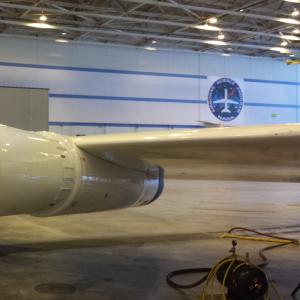The Airborne Scanning Microwave Limb Sounder (A-SMLS) makes wide-swath vertical profile observations of the composition
of the upper troposphere and lower stratosphere (the atmospheric region from ~10–20km altitude). A-SMLS measurements are
well suited to studies of convective outflow, long-range pollution transport, and exchange of air between the
troposphere and stratosphere. These atmospheric processes have strong impacts on climate and air quality but are
currently incompletely understood. Improved understanding of these issues is one of the main goals of NASA’s atmospheric
composition Earth science focus area. A-SMLS airborne observations reflect the priority spaceborne “Ozone and Trace Gas”
observables identified in the recent Decadal Survey.
A-SMLS was initially developed and flown on the WB-57 under the NASA Instrument Incubator Program (IIP), following
which, it was adapted to the ER-2 platform. Subsequent work, funded under an additional IIP, has upgraded the receivers
to ones that require cooling to only 70K rather than the previously needed 4K, and to use newer technology digital
spectrometers. Test flights for A-SMLS in this new configuration are planned, but further work, proposed here, is needed
to make the instrument fully “campaign ready”.
A-SMLS observes a ~300km-wide swath ~300km ahead of the aircraft in a 2D raster scan (azimuth and elevation), with
~10x10km horizontal sampling (across and along-track). As typically configured, A-SMLS measures water vapor, ozone, and
carbon monoxide. Retuning of the instrument (including in flight) can provide measurements of other species (including
N2O, HCN, CH3CN, H2CO, and others).
The instrument would be a particularly valuable addition to multi-aircraft campaigns. The broad swath A-SMLS
observations from the ER-2 could be used in near-real-time to help guide lower altitude aircraft carrying in situ
sensors to regions of interest.
As part of NASA's Airborne Instrument Technology Transition (AITT) program, the instrument is currently being updated to
help cement its suitability for campaign-mode operations, specifically, this involves:
- Addition of a liquid cooling loop to transfer waste heat from the existing ~70K cryocooler to the outer skin of the
ER-2 wing pod.
- Development of an “intelligent scan” system that accounts for aircraft orientation etc. when performing the 2D
raster limb scan on the atmosphere.
- Completion of a thorough ground-based instrument calibration.
- Development of an on-board radiance compression scheme that will enable key data to be transferred to the ground for
use in real-time flight planning as described above.
- Updates to the analysis algorithms software used for Aura MLS, enabling their application to A-SMLS observations.



